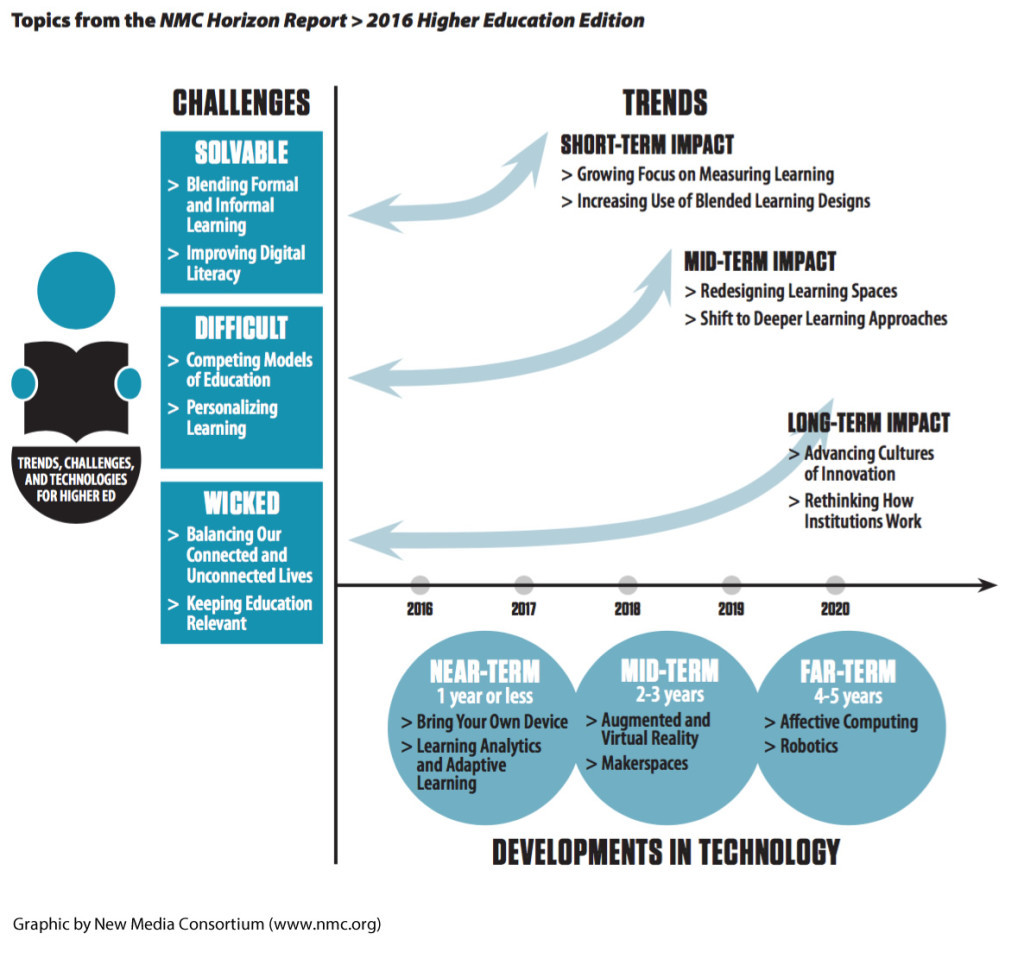We often tell students that they need to be organized to manage their workload when they take an online course. But, it is even more important for you to manage your own time when teaching an online course. The lack of pre-defined, scheduled class times, combined with navigating the tools for online grading and communication can make it feel overwhelming. This archived online workshop will introduce you to some strategies for keeping up with the course, techniques that can save you time, and best practices to manage student expectations of you, including some simple suggestions for saving time and increasing your efficiency.
Archives for February 2016
Latest Trends in Educational Technology Use Identified in 2016 Horizon Report
The New Media Consortium (NMC) and EDUCAUSE Learning Initiative (ELI) have jointly released the NMC Horizon Report > 2016 Higher Education Edition. This 13th edition describes annual findings from the NMC Horizon Project, an ongoing research project designed to identify and describe emerging technologies likely to have an impact on learning, teaching, and creative inquiry in higher education.
The report identifies six key trends, six significant challenges, and six important developments in educational technology across three adoption horizons spanning over the next one to five years, giving campus leaders, educational technologists, and faculty a valuable guide for strategic technology planning. The report provides higher education leaders with in-depth insight into how trends and challenges are accelerating and impeding the adoption of educational technology, along with their implications for policy, leadership, and practice.
“The release of this report kicks off the 15th year of the NMC Horizon Project, which has sparked crucial conversations and progressive strategies in institutions all over the world,”says Larry Johnson, Chief Executive Officer of the NMC. “We are so appreciative of ELI’s continued support and collaboration. Together we have been able to regularly provide timely analysis to universities and colleges.”
“This year’s report addresses a number of positive trends that are taking root in higher education,” notes ELI Director Malcolm Brown. “More institutions are developing programs that enable students and faculty to create and contribute innovations that advance national economies, and they are also reimagining the spaces and resources accessible to them to spur this kind of creativity.”
[Watch the video summary]
Key Trends Accelerating Higher Education Technology Adoption
The NMC Horizon Report > 2016 Higher Education Edition identifies “Advancing Cultures of Innovation” and “Rethinking How Institutions Work” as long-term impact trends that for years affected decision-making and will continue to accelerate the adoption of educational technology in higher education over the next five years. “Redesigning Learning Spaces” and the “Shift to Deeper Learning Approaches” are mid-term impact trends expected to drive technology use in the next three to five years; meanwhile, “Growing Focus on Measuring Learning” and “Increasing Use of Blended Learning” are short-term impact trends, anticipated to impact institutions for the next one to two years before becoming commonplace.
Significant Challenges Impeding Higher Education Technology Adoption
A number of challenges are acknowledged as barriers to the mainstream use of technology in higher education. “Blending Formal and Informal Learning” and “Improving Digital Literacy” are perceived as solvable challenges, meaning they are well-understood and solutions have been identified. “Competing Models of Education” and “Personalizing Learning” are considered difficult challenges, which are defined and well understood but with solutions that are elusive. Described as wicked challenges are “Balancing Our Connected and Unconnected Lives” and “Keeping Education Relevant.” Challenges in this category are complex to define, making them more difficult to address.
Important Developments in Educational Technology for Higher Education
Additionally, the report identifies bring your own device (BYOD) and learning analytics and adaptive learning as digital strategies and technologies expected to enter mainstream use in the near-term horizon of one year or less. Augmented and virtual reality technologies and makerspaces are seen in the mid-term horizon of two to three years; affective computing and robotics are seen emerging in the far-term horizon of four to five years.

The subject matter in this report was identified through a qualitative research process designed by the NMC and collaboratively conducted by the NMC and ELI that engaged an international body of experts in higher education, technology, business, and other fields around a set of research questions designed to surface significant trends and challenges and to identify emerging technologies with a strong likelihood of adoption in higher education. The report details the areas in which these experts were in strong agreement.
Quality Online Teaching: Feedback Strategies for Your Online Course
Students in an online course need feedback early and often, so that they can track their progress and improve their performance. There are many ways you can provide your online students with great feedback. In this archived online workshop, learn feedback strategies to incorporate into your online teaching and innovative ideas for faculty, student-to-student, and reflective feedback.
Quality Online Teaching: Best Practices for Delivering an Online Course
Teaching an online course is not so different from teaching a F2F course. You still need to communicate with your students, grade student work, and support their learning. There are some differences, though, and research has shown that following some best practices can increase student success. In this archived online workshop, find out how to best support your students in the online environment. You will discover practical strategies you can implement in your own online courses.
Trying Periscope for Video Discussion
There are many ways to quickly and easily share video today from mobile devices, with video becoming increasingly popular in web-based learning environments. While I try to model best practices of online course design and delivery in the courses I teach, I’m also curious to try new approaches and technologies to see their potential within online learning. One such intriguing technology that I’m curious to try is live mobile streaming video. To do so in our course, I’m going to use the free Periscope app for broadcasting and recording video announcements throughout my spring 2016 course, ETT 570: IT Leadership. If you’d like to try Periscope with me, simply download and install the free Periscope app onto your phone and then follow me within the Periscope app, username @jasonrhode. After doing so, when I post a start a live video broadcast on my phone, you’ll receive a push notification and can watch live and post questions/comments via text chat in real time while watching the video.
Exploring innovative avenues for enhancing online learning experiences, I’ve recently delved into the realm of live video streaming. As technology continues to advance, the landscape of education evolves, and incorporating live mobile streaming video presents an exciting prospect for engaging students in real-time interactions. Much like the spontaneity of a live video broadcast, webcam chats have become an integral part of virtual communication, fostering dynamic exchanges among participants. Considering the growing significance of video in web-based learning environments, it’s intriguing to delve into live video chat statistics to understand the impact and potential benefits of this interactive medium within educational contexts. By incorporating such insights into course design and delivery, educators can further enrich the online learning experience, creating dynamic and participatory virtual spaces for students to connect and collaborate.
After each live video broadcast, I plan to upload the video to our course YouTube playlist and post in Blackboard to the appropriate online discussion forum or as a new announcement, so even students who don’t try Periscope can still watch the recorded videos from me. Here’s an example of the recorded video from my most recent live video broadcast on Periscope.
I’ll be interested to hear feedback on my use of Periscope in the course and I think this could have MANY different educational applications. More to come!



